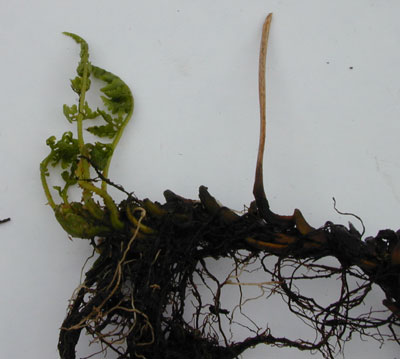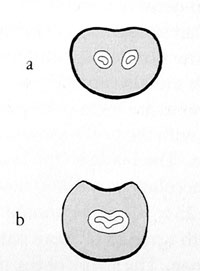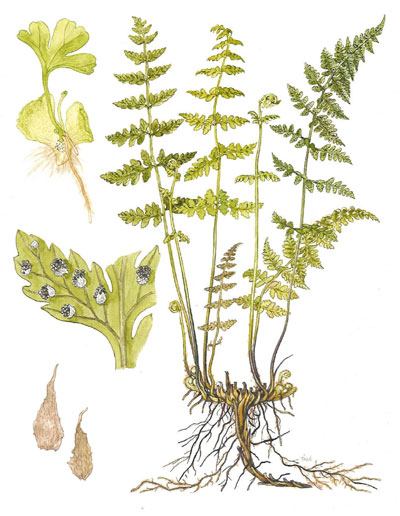| Cystopteris fragilis | ||
Fragile fern, brittle fern | ||
|
Etymology
Fragilis means brittle, easily broken, refering to the stipes.
Description
Rhizome: short-creeping, covered with old stipe bases, scales tan to light brown, lanceolate.
Frond: 40 cm high by 6 cm wide, deciduous, monomorphic, blade/stipe ratio: 1:1 or somewhat more. Stipe: stipes --3 to 8-- clustered at stem apex, grooved, dark at base, straw-colored to green above, sparsely scaly, vascular bundles: 2, round or oblong, merging at stipe apex in the drawing shown below, but not merging in Ferns of Northeastern United States. Blade: 2-pinnate-pinnatifid, ovate-lanceolate, herbaceous, glabrous. Pinnae: 8 to 15 pair, subopposite, anadromous, lanceolate, widest just below the middle, perpendicular to the rachis, ± opposite; costae grooves above continuous from rachis to costae; margins serrate to sharply dentate; veins free, simple or forked, ending usually at teeth, forking several times in the pinnule. Sori: round, in 1 row between midrib and margin, indusium: ovate to lanceolate, forming a hood over the sorus, but shriveling with maturity, beneath sorus on midrib side, sporangia: brown to black, maturity: midsummer to mid fall. Dimensionality: lowest pinnae pairs bending forward, down, nearly perpendicular to the plane of the frond. Culture
Habitat: calcareous cliff faces, also damp rocks and walls and on thin soil over rock, avoiding the most acidic rocks.
Distribution: temperate Northern and Southern Hemispheres, tropical montane in South America.
Hardy to -40°C, USDA Zone 2.
Synonyms
Polypodium fragile Linnaeus Cystopteris dickieana Sim |
|
|
Notes
Compare to Similar to C. protrusa in almost all respects, but the cluster of fronds is at the tip of the rhizome. Additionally, this is narrower, more than 2.5 times longer than wide; C. protrusa is broader, less than 2.5 times longer than wide.
Compare to C. dickieana, not listed here, has been used in more than one sense. Some references use it to refer to material with deeply wrinkled spore surfaces, contrasting this with the spiny surface of C. fragilis. Others restrict the name to the type material in the UK, which has fronds much more congested and pinnae held in the plane of the frond, a distinctly different taxon. It is not recognized, however.
See the drawing.
Compare to Similar to C. protrusa in almost all respects, but the cluster of fronds is at the tip of the rhizome. Additionally, this is narrower, more than 2.5 times longer than wide; C. protrusa is broader, less than 2.5 times longer than wide.
Compare to C. dickieana, not listed here, has been used in more than one sense. Some references use it to refer to material with deeply wrinkled spore surfaces, contrasting this with the spiny surface of C. fragilis. Others restrict the name to the type material in the UK, which has fronds much more congested and pinnae held in the plane of the frond, a distinctly different taxon. It is not recognized, however.
See the drawing.

Cystopteris fragilis. emergence, April 11, cluster of fronds, old stipe bases back on rhizome. Photo: Tom. |

Cystopteris fragilis. a) cross-section at stipe base, and b) near junction of stipe and rachis. Illustration from Scandinavian Ferns by Benjamin Øllgaard and Kirsten Tind, Rhodos, 1993. |
